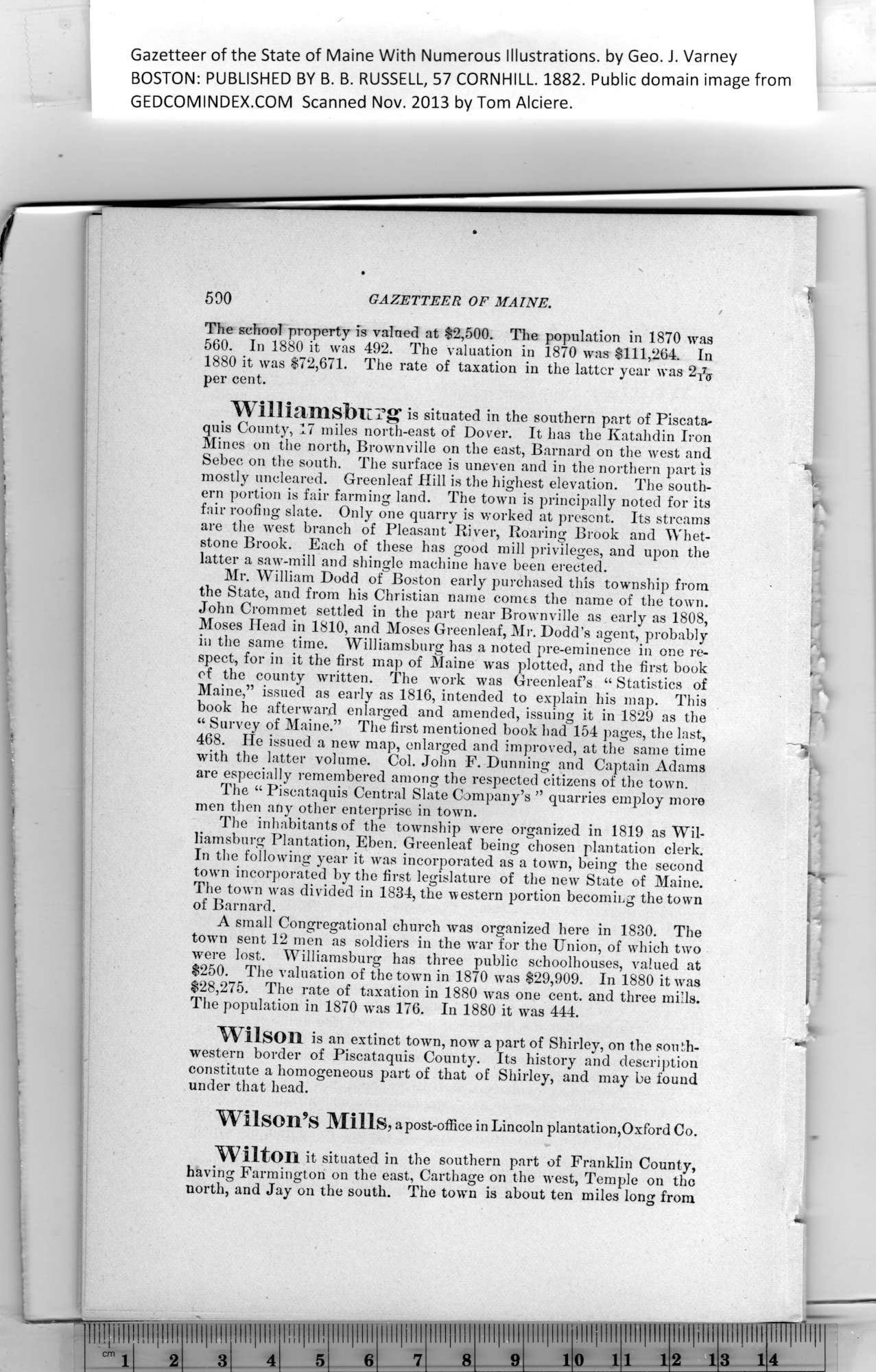|
Gazetteer of the State of Maine With Numerous Illustrations, by Geo. J. Varney
BOSTON: PUBLISHED BY B. B. RUSSELL, 57 CORNHILL. 1882. Public domain image from
590 GAZETTEER OF MAINE.
The school property is valued at $2,500. The population in 1870 was
560. In 1880 it was 492. The valuation in 1870 was $111,264. In
1880 it was $72,671. The rate of taxation in the latter year was 2/^
per cent.
Williamsburg’ is situated in the southern part of Piscata-
quis County, 17 miles north-east of Dover. It has the Katahdin Iron
Mines on the north, Brownville on the east, Barnard on the west and
Sebec on the south. The surface is uneven and in the northern part is
mostly uncleared. Greenleaf Hill is the highest elevation. The south-
ern portion is fair farming land. The town is principally noted for its
fair roofing slate. Only one quarry is worked at present. Its streams
are the west branch of Pleasant River, Roaring Brook and Whet-
stone Brook. Each of these has good mill privileges, and upon the
latter a saw-mill and shingle machine have been erected.
Mr. William Dodd of Boston early purchased this township from
the State, and from his Christian name comes the name of the town.
John Crommet settled in the part near Brownville as early as 1808,
Moses Head in 1810, and Moses Greenleaf, Mr. Dodd’s agent, probably
in the same time. Williamsburg has a noted pre-eminence in one re-
spect, for in it the first map of Maine w'as plotted, and the first book
ef the county written. The work was Greenleaf’s “ Statistics of
Maine,” issued as early as 1816, intended to explain his map. This
book he afterward enlarged and amended, issuing it in 1829 as the
“ Survey of Maine.” The first mentioned book had 154 pages, the last,
468. He issued a new map, enlarged and improved, at the same time
with the latter volume. Col. John F. Dunning and Captain Adams
are especially remembered among the respected citizens of the town.
The “ Piscataquis Central Slate Company’s ” quarries employ more
men then any other enterprise in town.
The inhabitants of the township were organized in 1819 as Wil-
liamsburg Plantation, Eben. Greenleaf being chosen plantation clerk.
In the following year it was incorporated as a town, being the second
town incorporated hy the first legislature of the new State of Maine.
The town was divided in 1834, the western portion becoming the town
of Barnard.
A small Congregational church was organized here in 1830. The
town sent 12 men as soldiers in the war for the Union, of which two
were lost. Williamsburg has three public schoolhouses, valued at
$250. The valuation of the town in 1870 was $29,909. In 1880 it was
$28,275. The rate of taxation in 1880 was one cent, and three mills.
The population in 1870 was 176. In 1880 it was 444.
Wilson is an extinct town, now a part of Shirley, on the south-
western border of Piscataquis County. Its history and description
constitute a homogeneous part of that of Shirley, and may be found
under that head.
Wilson’s Mills, apost-oflice in Lincoln plantation,Oxford Co.
Wilton it situated in the southern part of Franklin County,
having Farmington on the east, Carthage on the west, Temple on the
north, and Jay on the south. The town is about ten miles long from
PREVIOUS PAGE ... NEXT PAGE
This page was written in HTML using a program written in Python 3.2
|
